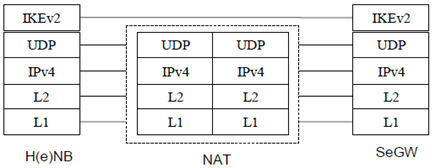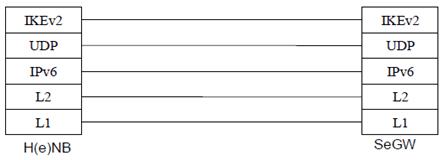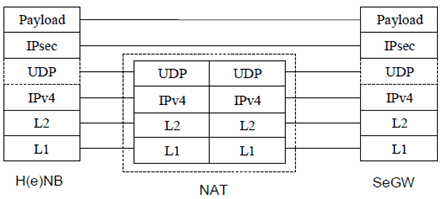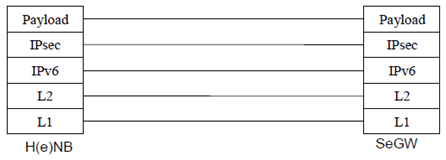TS 29.139
3GPP System - Fixed Broadband Access Network Interworking –
Home (e)Node B - Security Gateway Interface
V17.0.0 (PDF)
2022/03 14 p.
V16.0.0
2020/06 14 p.
V15.0.0
2018/06 13 p.
V14.0.0
2017/03 14 p.
V13.1.0
2016/03 14 p.
V12.1.0
2016/03 14 p.
V11.2.0
2016/03 14 p.
- Rapporteur:
- Mr. Yang, Yong
Ericsson LM
Content for TS 29.139 Word version: 17.0.0
1 Scope
2 References
3 Definitions and abbreviations
4 General
5 Supporting QoS
6 Tunnel Management
7 PDUs and parameters specific to the present document
$ Change History
1 Scope p. 5
The present document specifies the H(e)NB - SeGW interface. The interface is used for the interworking between a 3GPP system and a Fixed Broadband Access network defined by Broadband Forum. The interworking procedure provides the IP connectivity to a 3GPP UE using a H(e)NB connected to a Fixed Broadband Access network as specified in TS 23.139.
The specification covers the QoS aspects and Tunnel management procedures.
2 References p. 5
The following documents contain provisions which, through reference in this text, constitute provisions of the present document.
- References are either specific (identified by date of publication, edition number, version number, etc.) or non-specific.
- For a specific reference, subsequent revisions do not apply.
- For a non-specific reference, the latest version applies. In the case of a reference to a 3GPP document (including a GSM document), a non-specific reference implicitly refers to the latest version of that document in the same Release as the present document.
[1]
TR 21.905: "Vocabulary for 3GPP Specifications".
[2]
TS 23.139: "3GPP System-Fixed Broadband Access Network Interworking; Stage 2".
[3]
TS 24.139: "3GPP System-Fixed Broadband Access Network Interworking; Stage 3".
[4]
RFC 2474 (December 1998): "Definition of the Differentiated Services Field (DS Field) in the IPv4 and IPv6 Headers".
[5]
RFC 5996: " Internet Key Exchange Protocol Version 2 (IKEv2)".
[6]
RFC 3948: "UDP Encapsulation of IPsec ESP Packets".
[7]
TS 33.320: "Security of Home Node B (HNB) / Home evolved Node B (HeNB)".
3 Definitions and abbreviations p. 5
3.1 Definitions p. 5
For the purposes of the present document, the terms and definitions given in TR 21.905 and the following apply. A term defined in the present document takes precedence over the definition of the same term, if any, in TR 21.905.
H(e)NB Reflective QoS function:
H(e)NB Reflective QoS function is a H(e)NB function in order to support QoS for uplink traffic over a Fixed Broadband Access network as specified in TS 23.139.
H(e)NB local IP address Info:
H(e)NB local IP address Info is defined as either the public IPv4 address or IPv6 address assigned to the H(e)NB by the Fixed Broadband Access Network domain, or the public IPv4 address and the UDP port number used by the NATed RG that is used for this H(e)NB. The public IPv4 address used by the NATed RG is assigned by the Fixed Broadband Access Network domain.
3.2 Abbreviations p. 6
For the purposes of the present document, the abbreviations given in TR 21.905 and the following apply. An abbreviation defined in the present document takes precedence over the definition of the same abbreviation, if any, in TR 21.905.
DSCP
Differentiated Services Code Point
H(e)NB
Home (e)NodeB
NAT
Network Address Translation
NAT-T
NAT Traversal
SeGW
Security Gateway
4 General p. 6
4.1 Protocol Stack p. 6
4.1.1 Control Plane for H(e)NB - SeGW p. 6

Figure 4.1.1-1: Control Plane for H(e)NB - SeGW Interface over IPv4 transport network
(⇒ copy of original 3GPP image)
(⇒ copy of original 3GPP image)
Legend:
- IKEv2 Protocol: This protocol is used to between H(e)NB and SeGW. The IKEv2 protocol is defined in RFC 5996.

Figure 4.1.1-2: Control Plane for H(e)NB - SeGW Interface over IPv6 transport network
(⇒ copy of original 3GPP image)
(⇒ copy of original 3GPP image)
Legend:
- IKEv2 Protocol: This protocol is used to between H(e)NB and SeGW. The IKEv2 protocol is defined in RFC 5996.
4.1.2 User Plane for H(e)NB - SeGW p. 7

Figure 4.1.2-1: User Plane for H(e)NB - SeGW Interface over IPv4 transport network
(⇒ copy of original 3GPP image)
(⇒ copy of original 3GPP image)
Legend:
UDP: UDP encapsulation is used if NAT is detected between the H(e)NB and the SeGW.

Figure 4.1.2-2: User Plane for H(e)NB - SeGW Interface over IPv6 transport network
(⇒ copy of original 3GPP image)
(⇒ copy of original 3GPP image)
5 Supporting QoS p. 8
5.1 General p. 8
At interworking with a Fixed Broadband Access network, QoS is provided by DSCP marking as specified in RFC 2474.
5.2 H(e)NB procedures p. 8
5.2.1 General p. 8
The H(e)NB shall support DSCP marking on the IPsec header when forwarding the UE uplink traffic.
Based on H(e)NB configuration either the QCI mapping or the Reflective QoS may be used.
5.2.2 QCI mapping p. 8
The QCI mapping table contains a one-to-one mapping from QCI value to DSCP marking value. The QCI mapping table is configured in the H(e)NB by the operator.
When forwarding an uplink IP packet, the H(e)NB shall perform a lookup in the QCI mapping table based on the QCI value of the EPS bearer/PDP context before the IPsec tunnel encapsulation. The H(e)NB shall set the DSCP marking value of the IPsec header according to the matched QCI mapping table entry.
5.2.3 Reflective QoS p. 8
To support the H(e)NB Reflective QoS function for uplink traffic, the H(e)NB shall create and maintain the uplink DSCP marking rules for each active PDN connection as specified for UE Reflective QoS function in TS 24.139.
When forwarding an uplink IP packet, the H(e)NB shall perform a lookup in the DSCP marking table based on the n-tuple of the IP header before the IPsec tunnel encapsulation. If a matching entry is found, the H(e)NB shall set the DSCP marking value of the IPsec header according to the matched DSCP marking rule. If no matching entry is found, the H(e)NB shall copy the DSCP field of the outer IP header into the IPsec header before forwarding to the SeGW.
5.3 SeGW procedures p. 8
When receiving a downlink data packet, the SeGW shall copy the DSCP marking value from the outer IP header into the IPsec header before forwarding to the H(e)NB using the IPsec tunnel, as specified in TR 23.139.
6 Tunnel Management p. 8
6.1 General p. 8
The tunnel is an IPsec tunnel established via an IKEv2 protocol exchange RFC 5996 between the H(e)NB and the SeGW which is through the Fixed Broadband Access Network.
In an IPv4 Fixed Broadband Access Network, NAT can be deployed between the H(e)NB and the SeGW, e.g. in a Residence Gateway. A H(e)NB behind the NAT shall invoke the NAT traversal procedure for IKEv2. The IPsec tunnel is encapsulated over UDP in the Tunnel-Mode as specified in RFC 5996.
6.2 H(e)NB procedures p. 9
6.2.1 Tunnel establishment p. 9
6.2.1.1 IP address allocation p. 9
The SeGW shall provide the IP address to the H(e)NB for the communication with the EPC network.
For dynamic IP address allocation, the H(e)NB shall include the requested IP address type (IPv4 address or IPv6 address) that needs to be configured in an IKEv2 CFG_REQUEST Configuration Payload in the IKE_AUTH request message as defined in RFC 5996 after reception of the IKE_SA_INIT response from the SeGW.
6.2.1.2 NAT Traversal p. 9
NAT can be deployed in an IPv4 Fixed Broadband Access Network. IKEv2 NAT Traversal specified in Section 2.23 of RFC 5996 shall be supported by H(e)NB.
If NAT is detected between the H(e)NB and SeGW, the following procedures shall be performed:
6.2.1.3 H(e)NB NATed Tunnel-IP address discovery p. 9
If NAT is detected between the H(e)NB and SeGW, the H(e)NB shall request the SeGW to return the H(e)NB local IP address information by including the EXTERNAL_SOURCE_IP4_NAT_INFO attribute as defined in subclause 7.1.1.1 in the CFG_REQUEST Configuration Payload within the IKE_AUTH request message. The length field of the attribute shall be set to zero. The NATed IPv4 Address field and UDP Port number field shall be absent.
If the H(e)NB subsequently receives the EXTERNAL_SOURCE_IP4_NAT_INFO attribute in the CFG_REPLY configuration payload from the SeGW, the H(e)NB shall report the IP address received in EXTERNAL_SOURCE_IP4_NAT_INFO attribute as the H(e)NB local IP address to the MME/SGSN.
6.2.2 Tunnel modification p. 9
NAT mappings can change when the UDP port number is reassigned by the NAT, and/or H(e)NB local IP address is reallocated due to NAT restart.
Upon NAT remapping, the SeGW initiates the tunnel disconnection procedure as specified in subclause 6.3.3. Then the H(e)NB shall re-initiate the tunnel establishment procedure as specified in sub-clause 6.2.1.
6.2.3 Tunnel disconnection p. 9
The H(e)NB shall use the procedures defined in RFC 5996 to disconnect an IPsec tunnel to the SeGW.
6.3 SeGW procedures p. 9
6.3.1 Tunnel establishment p. 9
6.3.1.1 IP address allocation p. 9
For dynamic IP address allocation, upon receipt of an IKE_AUTH request message from the H(e)NB requesting the IP address, the SeGW shall include the remote IP address information in the IKEv2 Configuration Payload (CFG_REPLY) of the final IKE_AUTH response message to the H(e)NB. The SeGW shall assign either an IPv4 or an IPv6 address to the H(e)NB via a single CFG_REPLY Configuration Payload.
6.3.1.2 NAT Traversal p. 10
NAT can be deployed in an IPv4 Fixed Broadband Access Network. IKEv2 NAT Traversal specified in Section 2.23 of RFC 5996 shall be supported by SeGW.
If NAT is detected between the H(e)NB and SeGW, the SeGW shall use UDP-Encapsulated ESP as defined in RFC 5996.
6.3.1.3 H(e)NB NATed Tunnel-IP address discovery p. 10
If the SeGW receives the EXTERNAL_SOURCE_IP4_NAT_INFO attribute as defined in subclause 7.1.1.1 in the CFG_REQUEST configuration payload within IKE_AUTH request message, the SeGW shall provide the H(e)NB local IP address information (i.e. NATed IPv4 address and UDP port number) to the H(e)NB by including the EXTERNAL_SOURCE_IP4_NAT_INFO attribute in the CFG_REPLY configuration payload within the IKE_AUTH response message.
6.3.2 Tunnel modification p. 10
NAT mappings can change when the UDP port number is reassigned by the NAT, and/or H(e)NB local IP address is reallocated due to NAT restart.
If NAT remapping is detected by the SeGW, the SeGW shall initiate the tunnel disconnection procedure (see subclause 6.3.3).
6.3.3 Tunnel disconnection p. 10
The SeGW shall use the procedures defined in RFC 5996 to disconnect an IPsec tunnel to the H(e)NB.
7 PDUs and parameters specific to the present document p. 10
7.1 IETF RFC coding information defined within present document p. 10
7.1.1 IKEv2 Configuration Payloads attributes p. 10
7.1.1.1 EXTERNAL_SOURCE_IP4_NAT_INFO attribute p. 10
The format of the EXTERNAL_SOURCE_IP4_NAT_INFO attribute follows the definition of Configuration Attributes as specified in Section 3.15.1 of RFC 5996. The format is shown in Figure 7.1.1.1-1 as below. The length of the EXTERNAL_SOURCE_IP4_NAT_INFO attribute is 0 or 6 bytes.

The R bit in the first octet is as defined in RFC 5996.
The Attribute Type indicating EXTERNAL_SOURCE_IP4_NAT_INFO is of the value 23.